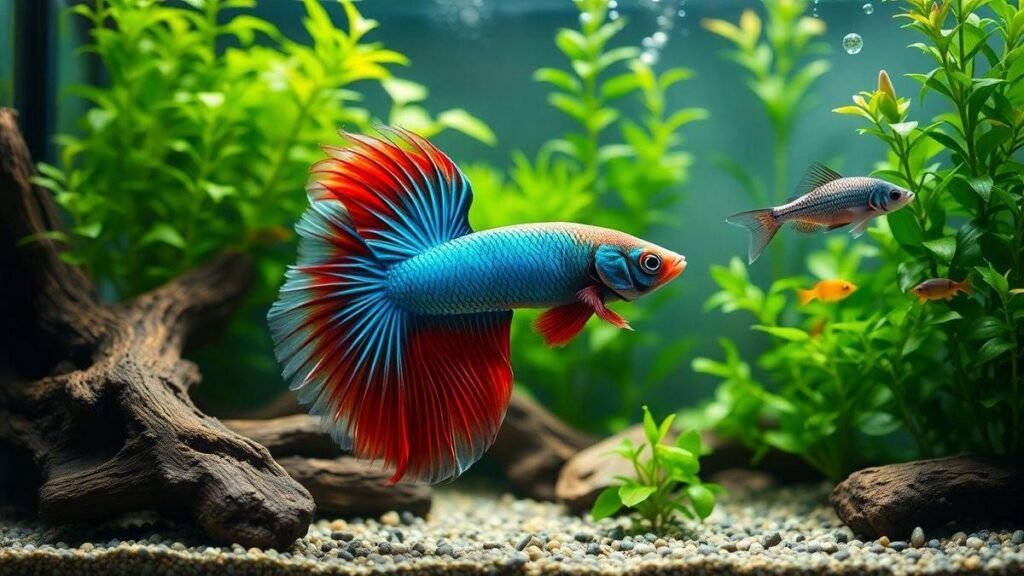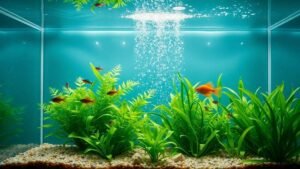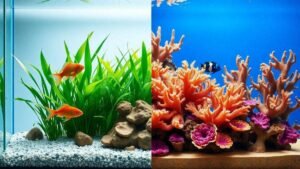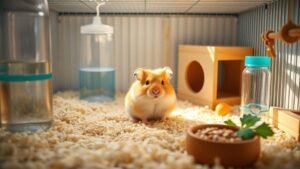Tips for a Calm Community Tank (Dicas para cuidar de peixes betta em aquário comunitário)
I want to help you set up a calm community tank for your betta. Follow these clear, practical steps to reduce stress and keep your betta healthy. The phrase “Dicas para cuidar de peixes betta em aquário comunitário” is used throughout as a compact reminder of the core advice.
Key takeaways
- Keep the tank warm and stable.
- Choose peaceful tank mates that won’t nip fins.
- Provide plenty of live plants and hiding spots.
- Watch behavior closely and act immediately on stress signs.
- Do small, regular water changes and use gentle filtration (see freshwater care and tank tips).
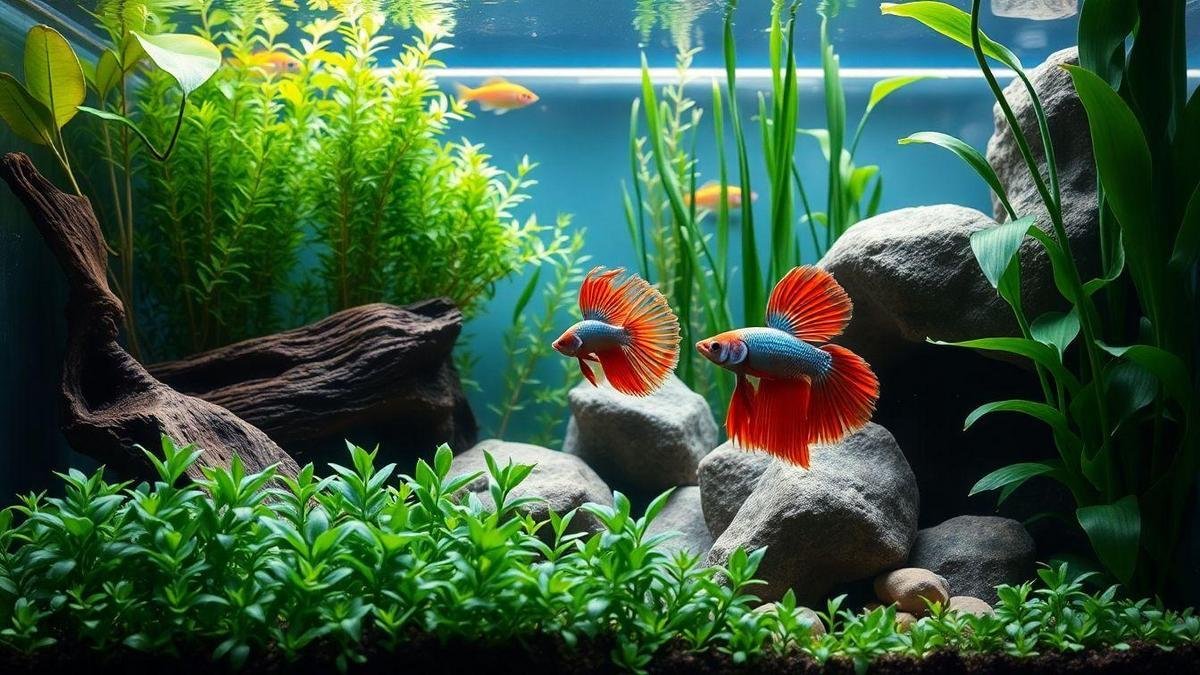
Tank size, plants and layout
Tank size: at least 10 gallons; 20 for full community
I moved my betta from a bowl into a 10‑gallon tank and saw calmer behavior almost immediately. For a true community tank with several tankmates, aim for 20 gallons. Larger tanks provide stable water, more swim space, and lower aggression — fundamentals covered in the freshwater fish care guide.
Benefits:
- Stable temperature and chemistry
- Room for plants and peaceful tankmates
- Betta swims more and flares less
Table — quick guide:
| Tank size | What I saw | Tip |
|---|---|---|
| 3–5 gal | Restless, jumping | Too small for community |
| 10 gal | Calmer, active | Good for a single betta |
| 20 gal | Best for small community | Recommended for multiple species |
Plants and hiding spots
Following “Dicas para cuidar de peixes betta em aquário comunitário”, I use low‑light plants and soft leaves so the betta can move without tearing fins. I place cover along the sides/back and keep the center open. For ideas on arranging a pet‑friendly space, see tips on creating a pet‑friendly indoor space.
Go‑to plants:
- Anubias — low light, attaches to wood/rock
- Java fern — tough leaves, back/mid placement
- Java moss — cover for shy fish
- Frogbit — floating shade; bettas rest underneath
Table — placement:
| Plant | Light | Placement |
|---|---|---|
| Anubias | Low | Mid/back, on wood |
| Java fern | Low | Back corners |
| Java moss | Low | Foreground, decorations |
Layout balance
Keep about half to two‑thirds of the tank open for swimming. Place tall plants in the back, caves/rocks on the sides, and open lanes in the center. If your betta hides all day, adjust plants to create more open space — good layout strategies are part of general pet‑care planning like comprehensive care guides.
Choosing tank mates (Dicas para cuidar de peixes betta em aquário comunitário)
Pick peaceful species with similar water needs
Bettas prefer warm, slightly acidic to neutral water. Target 24–28°C (75–82°F) and pH 6.5–7.5. Choose tankmates that occupy different zones and fit those ranges.
Examples I use:
- Corydoras (small species) — bottom, 22–26°C, peaceful
- Otocinclus — algae eater, shy, 22–28°C
- Nerite snail — clean-up crew, no fin interest
Table — compatibility:
| Species | Tank zone | Temp (°C) | pH | Why |
|---|---|---|---|---|
| Corydoras | Bottom | 22–26 | 6.5–7.5 | Gentle, avoid betta’s space |
| Otocinclus | Mid-bottom | 22–28 | 6.8–7.5 | Small algae eater |
| Nerite snail | All levels | 20–28 | 6.5–8.0 | No fin interest, cleans algae |
Avoid fin‑nippers and flashy males
Do NOT keep:
- Tiger barbs, serpae tetras (nippers/aggro)
- Brightly colored males that mimic betta rivals
- Large cichlids or territorial gouramis
Quick checklist before adding a fish:
- Will it nip fins? → No = OK
- Does it share water needs? → Yes = OK
- Is it a flashy male? → Avoid
Always check compatibility charts, but prioritize real observations. Quarantine every new fish for at least a week; practical quarantine routines are covered in the freshwater care guide and in general pet introduction resources like how to safely introduce new pets.
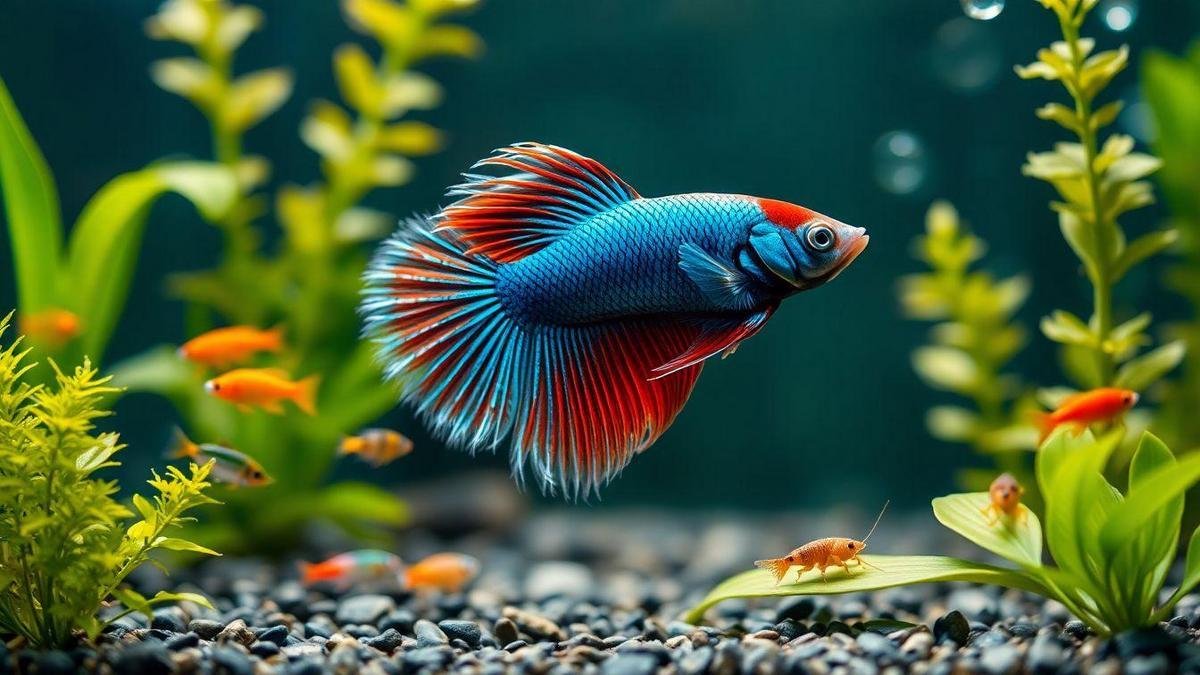
Introducing a betta to a community tank safely
Acclimation and divider method
Steps I use:
- Quarantine new fish first.
- Float the bag 15–20 minutes to match temperature.
- Add small amounts of tank water to the bag every 5 minutes for 30–45 minutes.
- Place the betta in a clear divider inside the tank for 24–72 hours so they can see each other without contact.
- Remove divider only after calm interactions.
For broader introduction and household integration techniques that apply to pets, see guidance on introducing new pets and ways to keep animals calm while changes occur (keeping pets calm during changes).
Acclimation timeline:
| Step | Time | Action |
|---|---|---|
| Float bag | 15–20 min | Match temperature |
| Mix water | 30–45 min | Add tank water gradually |
| Divider | 24–72 hrs | Let them inspect safely |
| Full release | After observation | Only if calm |
If chasing or torn fins appears, remove the newcomer or move the betta to a hospital tank.
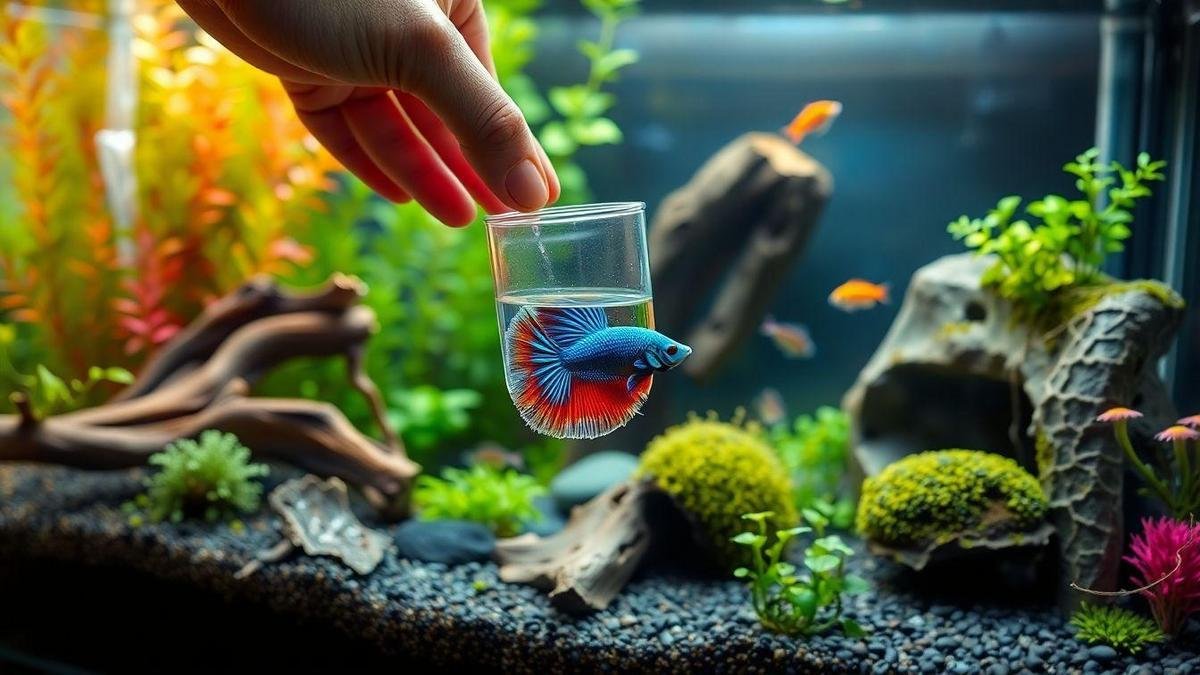
Reading betta behavior and stress signs
Signs to watch
Key signals:
- Flared gills — possible oxygen/water problem
- Clamped fins — stress, cold, or illness
- Lethargy — poor water, low temp, sickness
- Loss of appetite — stress or internal issues
Table — signs and first actions:
| Sign | What it often means | First action |
|---|---|---|
| Flared gills | Low oxygen or poor water | Test oxygen/temp; add gentle surface agitation |
| Clamped fins | Cold, illness, stress | Test water; lower light; watch for disease |
| Lethargy | Poor water or sickness | Check temp/water quality; feed less |
| Loss of appetite | Stress/internal | Check water; watch for other signs; fast 24 hrs |
For calming and confidence‑building techniques that apply across species, including reducing stress in indoor pets, see tips to help pets feel safe indoors.
When to act fast
Rules I follow:
- Immediate: breathing trouble, sudden color loss, frantic swimming
- Fast: not eating > 48 hours, clamped fins, visible wounds
- Monitor: brief hiding, slight color dulling
If stressed, test water and reduce light/noise immediately: aim for ammonia 0 ppm, nitrite 0 ppm, nitrate <20 ppm, temp 76–80°F (24–27°C).
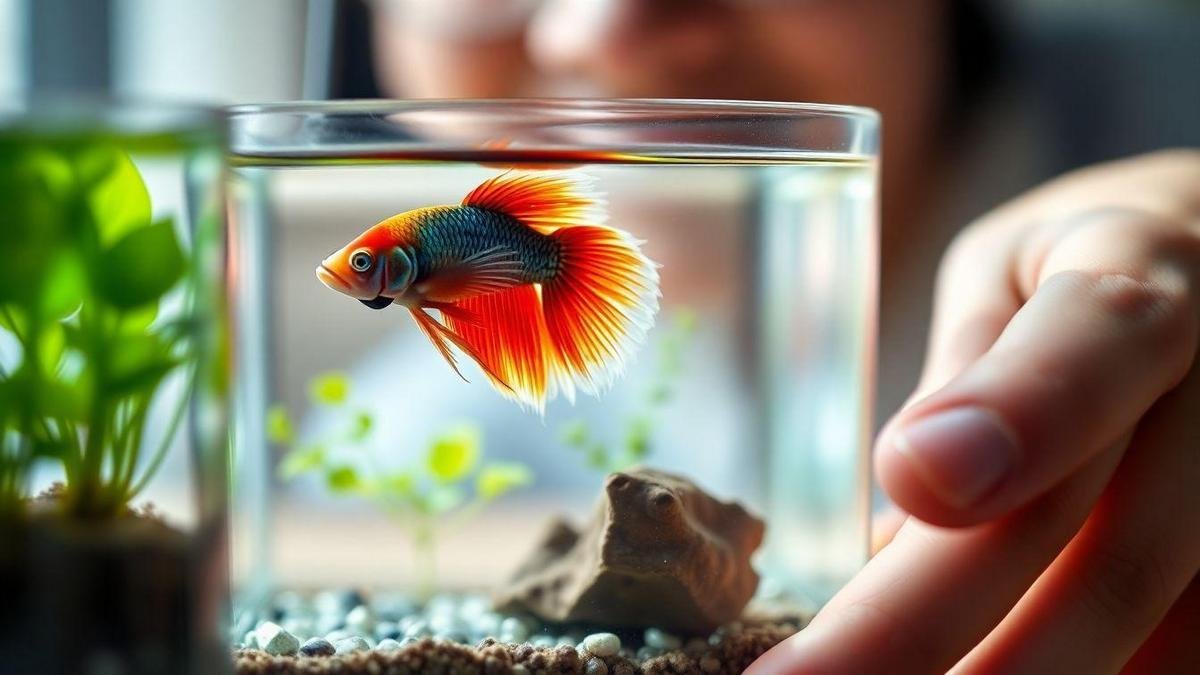
Feeding without causing fights
Target-feed high‑protein foods
I give my betta varied, high‑protein foods and target‑feed with a pipette or small stick so the betta gets its share when tankmates rush food. For keeping feeding areas clean and safe, follow general tips on pet food and water safety.
Foods and presentation:
| Food | Why | How I present it |
|---|---|---|
| Pellets (sinking/slow-sink) | Daily protein | One small pellet near the betta with a pipette |
| Frozen/live brine shrimp | High protein treat | Drop near the betta |
| Bloodworms (frozen) | Occasional treat | Small pieces, offered directly |
| Vegetable bits | For grazers | Place away from betta feeding spot |
Small meals and supervision
Feed 2–3 tiny meals spaced through the day. Watch for chasing. If swarming occurs:
- Feed the betta first in a quiet spot
- Drop other foods at the opposite end for bottom feeders
- Use a feeding ring or tube to separate zones
Remove uneaten food after 3–5 minutes to keep water clean.
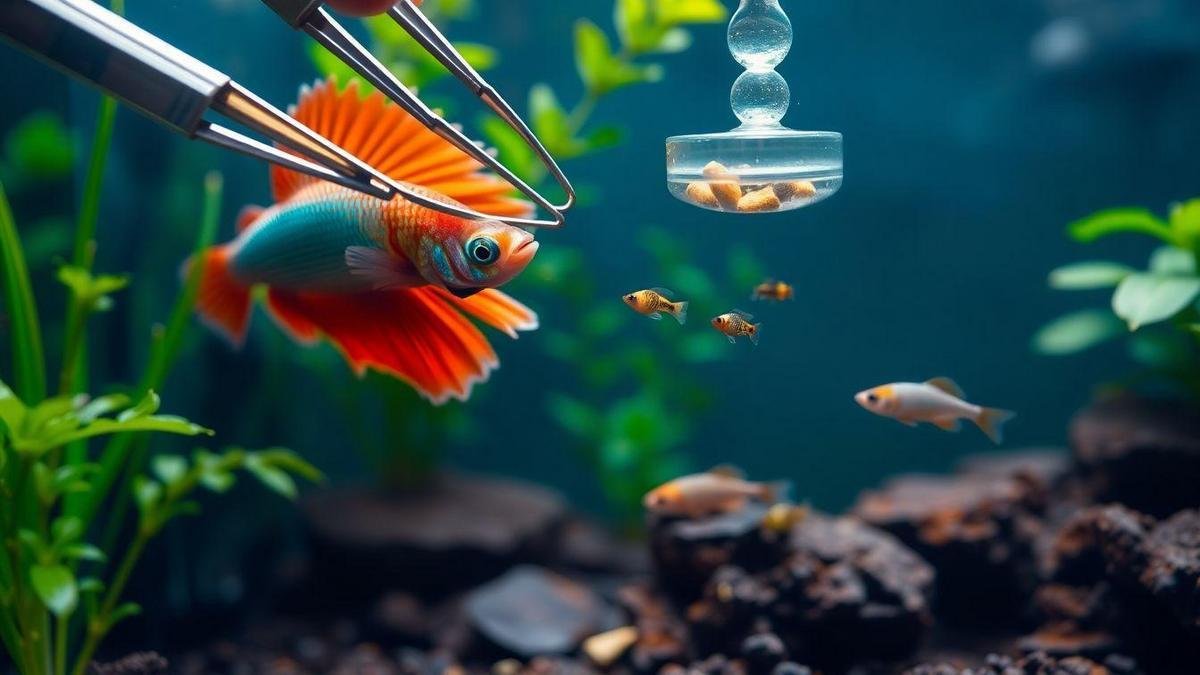
Quarantine and disease prevention
Quarantine new fish ~ two weeks
Always keep new arrivals in a small tank or tub with heater and sponge filter for about two weeks. Watch for faded color, torn fins, white spots, or erratic breathing. Early treatment can be as simple as a water change or a short salt bath (only if species tolerate it). Contact an experienced aquarist or vet if needed. See further freshwater care recommendations at freshwater fish care and tank tips.
Monitor water parameters regularly
Test ammonia, nitrite, nitrate, and pH at least weekly in the community tank and more often during cycling or illness. Record results to spot trends.
Healthy targets I use:
| Parameter | Target |
|---|---|
| Ammonia | 0 ppm |
| Nitrite | 0 ppm |
| Nitrate | <20–40 ppm (lower is better) |
| pH | 6.5–7.5 (I aim 6.8–7.2) |
If ammonia or nitrite appears, do a large water change and inspect the filter. If nitrate climbs, step up water changes and prune plants.
Regular maintenance routine
- Weekly water change: 25–40% (40–50% for heavy stocking or illness)
- Siphon gravel to remove debris
- Rinse mechanical filter media in removed tank water — never all at once
- Keep biological media intact; replace only if failing
- Soften strong filter flow with a sponge if needed
For ways to keep cleaning manageable and low‑stress, check practical advice on maintaining a clean home with pets and on keeping pets safe during cleaning.
These steady tasks prevent disease and keep your betta calm.
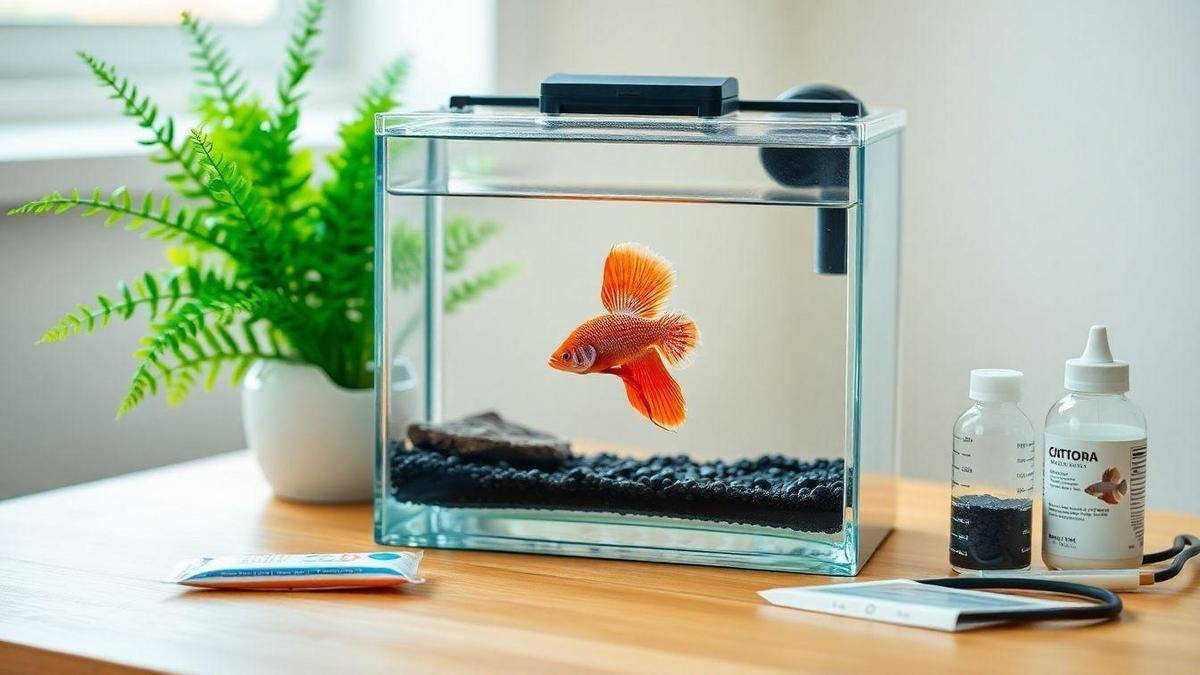
Quick reference checklist — Dicas para cuidar de peixes betta em aquário comunitario
- Tank: 10 gal for single betta, 20 gal for community
- Temp: 24–28°C (75–82°F); pH 6.5–7.5
- Plants & hiding: provide dense sides/back, open center
- Tankmates: peaceful, non‑nipping, similar water needs
- Acclimation: float bag, mix water, use divider 24–72 hrs
- Quarantine: ~2 weeks for all new fish
- Water tests: ammonia/nitrite 0 ppm, nitrate <20 ppm
- Feed: target‑feed high‑protein, remove uneaten food after 3–5 min
- Maintenance: weekly 25–40% water changes; gentle filtration
You can explore more related topics and practical examples on the site’s post index.
Conclusion
A calm community tank for a betta comes down to solid basics: the right tank size, live plants, cozy hiding spots, careful tankmate choices, slow introductions, and steady water maintenance. Watch behavior closely and act quickly on stress signs. Small, consistent actions make a big difference.
If you want more practical tips and real‑life examples, browse the site’s collection of resources at BlogCraelo — all posts or learn about the team on our about us page.
Frequently asked questions
Q: Which fish are safe with my betta in a community tank?
A: Pick peaceful, small fish that occupy different zones (Corydoras, Otocinclus, nerite snails). Avoid nippers and flashy males. See compatibility suggestions in the freshwater care guide.
Q: What tank size works best for a betta in a community?
A: At least 10 gallons for one betta; 20 gallons is recommended for a multi‑species community.
Q: How do I feed my betta without overfeeding others?
A: Use sinking pellets and target‑feed the betta first. Remove leftovers quickly; keeping feeding areas tidy helps and is covered in food and water safety tips.
Q: How often should I do water changes and tests?
A: Weekly 25–40% water changes and weekly parameter checks. Increase frequency for heavy stocking or signs of trouble.
Q: What are the top “Dicas para cuidar de peixes betta em aquário comunitario” I should follow?
A: Provide hiding spots and plants, choose calm tankmates, quarantine new fish, match water conditions, introduce slowly, and monitor behavior and water quality. For broader pet introduction and calming methods, see guidance on introducing new pets and keeping pets calm during changes.

